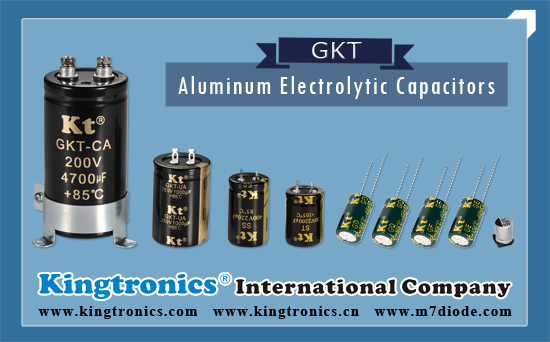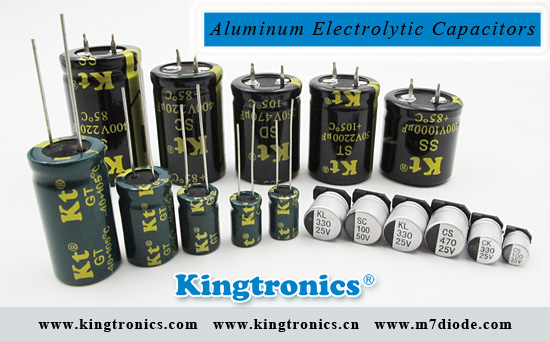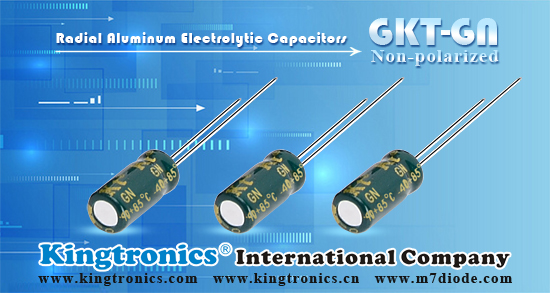Kingtronics produce and sell a wide variety of Aluminum Electrolytic Capacitors with long life, low Impedance and excellent performance options.
Welcome your inquiry for more information.
Catalogue:
http://www.kingtronics.com/pdf/Kingtronics-Aluminum-Electrolytic-Capacitors-Catalog.pdf
Product Video:
https://www.youtube.com/watch?v=dOTQpigQKgc
*Load Life: 1000Hr ~10000Hr
*Operating temperatures: 85°C, 105°C, 130°C
*Capacitance: 3.3uF - 22000uF
*Voltage range: 6.3 ~ 160 WV
*ISO/RoHS certified quality
* Axial Type, Radial Type, SMD Chip Type, Snap-in Type, Screw Type and Lug Type
*Package: Ammo, Bulk, Tape & Reel 
- 0Commentary
- Tags:Kt kingtronics Aluminum Electrolytic Capacitors GKT GKT Series GKT-GD GKT-GE GKT-GF GKT-GG GKT-GH GKT-GL GKT-GN GKT-GQ GKT-GR GKT-GZ GKT-SS GKT-VC GKT-VE GKT-VN GKT-VZ Radial Aluminum Electrolytic Capacitors SMD Aluminum Electrolytic Capacitors Axial Aluminum Electrolytic Capacitors Snap-in Type
When using Aluminum Electrolytic Capacitors, please observe the following points to ensure optimum capacitor performance and long life.
1>DC electrolytic capacitors are polarized.
Make sure of the polarity which is marked on the body of the capacitor.
Application of the reversed voltage may cause a short circuit or damage to the capacitor.
Use bipolar capacitors when the polarity is not determined or unknown.
Note that DC electrolytic capacitors CAN NOT be used for AC application.
2>Bipolar capacitors
These capacitors are used only in pulse circuits as well as polarity reverse circuits, but not applicable in pure AC or high ripple current.
3>Do not apply voltage greater than the rated voltage
If a voltage exceeding the rated voltage is applied, the leakage current will increase, which will damage the capacitor.
Recommended working voltage is 70% - 80% of rated voltage.
Using capacitors at recommended working voltage prolongs capacitor life.
4>Do not allow excessive ripple current through the capacitor
The flow of ripple current greater than the permissible (rated) value will cause heating of the capacitor, which may decrease the capacitance and damage the capacitor.
Ripple current through the capacitor must be at or below the allowable level, generally not more than 80% of the rated current.
5>Use specially designed capacitors for the circuits where charge and discharge are frequently repeated.
In circuits subjected to rapid charge and discharge cycles, a capacitor may be damaged and its life may be shortened by capacitance decrease at higher temperature.
6. Operating temperature range.
The characteristics of capacitors change with the operating temperature.
The capacitance and leakage current increase and dissipation factor will decrease at higher temperatures. Usage at lower temperature will ensure longer life.
7. Temperature vs. Life.
The expected life of a capacitor is related to its ambient temperature.
Generally, if the ambient temperature is reduced 10℃, life is doubled at rated voltage.
8. Check operating frequency.
Electrolytes usually have their capacitance measured at 100 Hz. or 120 Hz.
However, remember that capacitance decreases and dissipation factor increase as the applied frequency becomes higher.
9. Capacitor Storage
Long periods of storage have virtually no effect on a capacitor’s capacitance and dissipation factor.
However, such periods can increase leakage current and decrease the capacitors withstand voltage.
Apply rated DC voltage treatment to the capacitors which have been stored for a long time.
10. The capacitor case is not insulated from the cathode terminal.
The capacitor’s case and cathode terminal connect through the electrolyte.
If the case is to be completely insulated, that insulation must be at the capacitor’s mounting point.
11. Do not apply excessive force to the terminals and leads.
An excessively strong force applied to the terminals and lead wires may cause leads to break or terminals to separate and, in turn, cause the internal contact to fail.
12. Cleaning of the circuit board after solder dipping.
Clean circuit boards to remove flux or other extraneous matter.
To ensure protection for the sleeve, its marking, and the capacitor's sealing materials, the capacitor should never be washed or cleaned by halogenous agents or solvents such as trichlorethylene, xylene, acetone, etc.
Recommended cleaning solvents; Methanol, isopropanol ethanol, isobutene, petroleum ether, propanol and/ or commercial detergents.
13. Be cautious of the temperature and duration when soldering.
Soldering irons should be kept away from vinyl-insulated sleeves of capacitor.
When the capacitor is dipped in a solder bath, use at less than 260℃ and 10 seconds to avoid damaging the capacitor.
14. Hole positions on the circuit board.
When designing a circuit board, space the through-holes equal to the space between the capacitor's lead wires.
If the spacing is either greater than or less than the capacitor's leads, mounting will apply stress to the leads, causing short circuits, broken circuits, and increased current.
Also, through-holes on the circuit board as well as lead holes of post-process parts can result in solder splashing onto the vinyl sleeve causing damage.
Consider hole positions carefully.
Kingtronics produces high-quality Capacitors and sells around the world, GKT-GN Radial Aluminum Electrolytic Capacitor is one of the bestsellers with competitive price, the only different characteristic- non-polarized, used in polarity reverse and change circuits. Here are some details about GKT-GN Radial Lead type E Cap.
Features of GKT-GN Radial Through-hole Aluminum Electrolytic Capacitors:
Various dimensions: 5*11mm - 19*35mm
Long load life: 1000Hrs
ISO/RoHS certified quality
Specification of GKT-GN Radial Through-hole Aluminum Electrolytic Capacitors:
Operating temperature range: -40℃~+85℃
Voltage range: 6.3Vdc-160Vdc,
Wide range capacitance: 0.47uF - 6800uF
What are you waiting for? Come and place an order with us, you’ll never regret it! More information please visit Kingtronics website:
http://www.kingtronics.com/aluminum-electrolytic-capacitors/GKT-GN-85C-Radial-Aluminum-Electrolytic-Capacitors.html
Contact us
Tel: (86) 769 8118 8110
Tel: (852) 8106 7033
Fax: (852) 8106 7099
E-mail: info@kingtronics.com
Skype: kingtronics.sales
MSN: kingtronics-sales@hotmail.com
Web: www.Kingtronics.com
YouTube: www.youtube.com/c/Kingtronicskt
About
Kingtronics International Company was established in 1995 located in Dongguan City of China to handle all sales & marketing for factories located in Chengdu, Sichuan and Zhaoqing, Guangdong, China. In 1990, we established the first factory to produce trimming potentiometer and in 1999 we built up new factory in Zhao Qing, Guangdong. Now with around 850 workers, Kingtronics produce trimming potentiometers, dipped tantalum capacitors, multilayer ceramic capacitors, and diode & bridge rectifier. We sell good quality under our brand Kingtronics, and Kt, King, Kingtronics are our three trademarks. All our products are RoHS compliant, and our bridge rectifier have UL approval. Please visit our Products page, you could please download all our PDF datasheet and find cross reference for our Trimming Potentiometer and capacitors.
Tantalum and Ceramic Capacitors Cross Reference ↓ Download
Diodes & Rectifiers List(PDF: 97KB) ↓ Download
Trimming Potentiometer Cross Reference ↓Download
Categories
- Kt Kingtronics (245)
- Diodes & Rectifiers (159)
- Aluminum Electrolytic Capacitor (149)
- Trimming Potentiometers (123)
- Tantalum Capacitors (94)
- Multilayer Ceramic Capacitors (70)
- Kt Bridge Rectifier (64)
- Quartz Crystals (58)
- Surge Arresters (34)
- Tactile Switches (32)
- Kt Kingtronics Components (30)
- Ceramic Trimmer Capacitors (25)
- Film Capacitors (23)
- Super Capacitors (17)
- Metal Oxide Varistor (10)
- Negative Temperature Coefficient Thermistor (6)
- Music capacitors (2)
Archives
- 2024 April (2)
- 2024 March (2)
- 2024 February (2)
- 2024 January (3)
- 2023 December (1)
- 2023 November (2)
- 2023 October (1)
- 2023 September (2)
- 2023 August (2)
- 2023 July (4)
- 2023 June (12)
- 2023 May (6)
- 2023 April (4)
- 2023 March (3)
- 2023 February (2)
- 2023 January (1)
- 2022 December (3)
- 2022 November (2)
- 2022 October (3)
- 2022 September (4)
- 2022 August (3)
- 2022 July (3)
- 2022 June (2)
- 2022 May (3)
- 2022 April (4)
- 2022 March (4)
- 2022 February (2)
- 2022 January (3)
- 2021 December (4)
- 2021 November (3)
- 2021 October (4)
- 2021 September (4)
- 2021 August (4)
- 2021 July (4)
- 2021 June (5)
- 2021 May (4)
- 2021 April (3)
- 2021 March (4)
- 2021 February (4)
- 2021 January (4)
- 2020 December (5)
- 2020 November (4)
- 2020 October (4)
- 2020 September (7)
- 2020 August (8)
- 2020 July (9)
- 2020 June (8)
- 2020 May (9)
- 2020 April (11)
- 2020 March (6)
- 2020 February (4)
- 2020 January (4)
- 2019 December (6)
- 2019 November (7)
- 2019 October (6)
- 2019 September (5)
- 2019 August (9)
- 2019 July (6)
- 2019 June (4)
- 2019 May (16)
- 2019 April (6)
- 2019 March (6)
- 2019 February (9)
- 2019 January (5)
- 2018 December (4)
- 2018 November (4)
- 2018 October (5)
- 2018 September (8)
- 2018 August (10)
- 2018 July (7)
- 2018 June (12)
- 2018 May (22)
- 2018 April (4)
- 2018 March (4)
- 2018 February (8)
- 2018 January (13)
- 2017 December (4)
- 2017 November (4)
- 2017 October (5)
- 2017 September (4)
- 2017 August (21)
- 2017 July (7)
- 2017 June (5)
- 2017 May (4)
- 2017 April (4)
- 2017 March (9)
- 2017 February (8)
- 2017 January (8)
- 2016 December (10)
- 2016 November (16)
- 2016 October (8)
- 2016 September (10)
- 2016 August (13)
- 2016 July (12)
- 2016 June (10)
- 2016 May (14)
- 2016 April (8)
- 2016 March (10)
- 2016 February (6)
- 2016 January (8)
- 2015 December (10)
- 2015 November (8)
- 2015 October (3)
- 2015 July (5)
- 2015 June (9)
- 2015 May (7)
- 2015 April (8)
- 2015 March (9)
- 2015 February (7)
- 2015 January (5)
- 2014 December (13)
- 2014 November (4)
- 2014 October (4)
- 2014 September (5)
- 2014 August (4)
- 2014 July (4)
- 2014 June (4)
- 2014 May (4)
- 2014 April (4)
- 2014 March (5)
- 2014 February (3)
- 2014 January (4)
- 2013 December (8)
- 2013 November (9)
- 2013 October (10)
- 2013 September (9)
- 2013 August (11)
- 2013 July (10)
- 2013 June (3)
- 2013 May (4)
- 2013 April (5)
- 2013 March (2)
- 2013 February (1)
- 2013 January (3)
- 2012 December (5)
- 2012 November (6)
- 2012 October (5)
- 2012 September (10)
- 2012 August (11)
- 2012 July (11)
- 2012 June (12)
- 2012 May (14)
- 2012 April (10)
- 2012 March (14)
- 2012 February (10)
- 2012 January (6)
- 2011 December (9)
- 2011 November (11)
- 2011 October (10)
- 2011 September (13)
- 2011 August (14)
- 2011 July (13)
- 2011 June (13)
- 2011 May (13)
- 2011 April (14)
- 2011 March (27)
- 2011 February (13)
- 2011 January (24)
- 2010 December (21)
- 2010 November (12)
- 2010 October (11)
